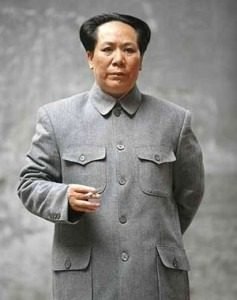By ZOU MIAO
Fashion & Style correspondent
BEIJING (China Daily Show) — China’s ruling Politburo have surprised hairdressers by formally admitting that the style sported by former Communist Party Chairman and father of Chinese Communism Mao Zedong is now “unfashionable.”
A Ministry of Culture press release issued shortly after New Year’s Day stated that the bizarre bob-cum-combover Mao wore from the early 1930s was “70% completely right and 30% just plain wrong” and the Party officially discourages today’s youngsters from trying to emulate the distinctive style.
The remarks reflect the attitudes of a rising generation of young Chinese, who increasingly prefer the spiky haircuts sported by Korean and Taiwanese pop stars to the Bactrian camel-effect made popular by the late Communist leader.

“Mao’s look was originally conceived as a bold break from the conservative, scraped-back and unimaginative queues and crew-cuts worn by Nationalist government figures,” said noted philanthropist, historian and Sinologist Sir William Buckfast.
“Chiang Kai’s haircut in particular was deeply unpopular among large swathes of the provincial population and looking at it today, one can see he was practically bald.
“By contrast, Mao’s cutting-edge, back-combed, double-parting immediately bought him vital credibility with the peasantry during his early years of struggle,” Sir William added.
“The worst excesses of the Great Helmsman’s hairstyling came during the decade of chaotic social upheaval known as the Cultural Revolution,” Sir William told China Daily Show. “During this time, Mao’s long-standing barber, Quentin Li Feng, was purged and his fourth wife, Jiang Qing, gave him all his fashion advice. This is what led to the unfortunate ‘undersized headphones’ look we remember him for today.”
Mao experimented with several looks during his early political career, including a mullet, cowlick and, most controversially, a 1911 pompadour before settling on his now-classic cut.
Although the Party insists this was a carefully conceived Marxist ‘do, historians believe it was it was in fact necessitated by the Red Army’s famous Long March of 1934, when the future Chairman would often face days without access to a hairdryer and had to fashion combs from beaten-flat shell casings.
“This style was probably considered fine then, as there was a war on,” said celebrity British hair stylist Nicky Clarke, who recently visited China for the first time. “But you can’t treat your hair the same way in peacetime. When the fighting stops, hair needs care and attention — gentle conditioning and minimal blow-drying — to achieve long-lasting and pliable results.”
While popular support for Mao’s topiary has been in steady decline since the 1970s, the Party line has until now rigidly supported the style as “the grandfather of Chinese haircuts.”
The new ruling is thus seen as a move by present-day leaders to distance themselves from a form of personal grooming increasingly at odds with contemporary Chinese values.
Got a tip? Contact us at cds@chinadailyshow.net
Follow this and other leading China news at @chinadailyshow on Twitter
